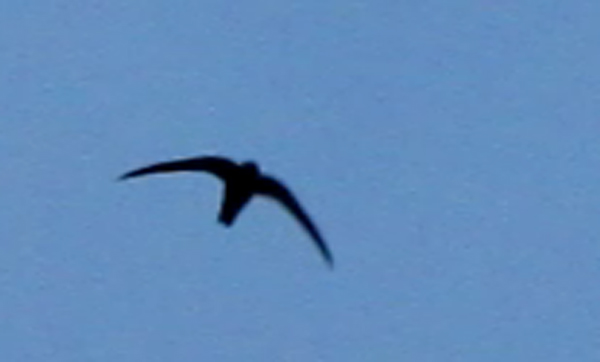 |
||
| Common name: |
Black Swift |
|
| Scientific name: | Cypseloides niger | |
| Date: | 7-30-12/7-31-12 | |
| Time: | 8 to 9pm(30th) 6am and 7:30am (31st) | |
| Length of time observed: | 1 hour(30th),20 minutes | |
| Number: | 3(30th),2(31st) | |
| Age: | adult | |
| Sex: | 1 male,1 female,1 unkown | |
| Location: | Little Deer Creek Falls along the north for of the Duchscene river | |
| County: | Duchesne | |
| Latilong: | ||
| Elevation: | 8,200 feet | |
| Distance to bird: | 80 feet at closest approach | |
| Optical equipment: | 10X50 binoculars,Canon SX20is Digital Camera | |
| Weather: | partly cloudy | |
| Light Conditions: | poor,as the sun had set behind the mountain,but with enough light to make out ID details | |
| Description: Size of bird: | Large Swift | |
| (Description:) Basic Shape: | very long narrow wings,relatively short stout body | |
| (Description:) Overall Pattern: | solid black | |
| (Description:) Bill Type: | very small | |
|
(Description:)
Field Marks and Identifying Characteristics: |
On Sunday night,still thinking about finding a new nest site for Black Swifts,I
did an image search on flickr for "Uinta Waterfalls" which produced several
pages of results. As I looked through them,one of them looked like a good
candidate falls and was near a side road off the mirror lake highway,so I
though,"lets go check it out". Come Monday afternoon I found my self at the
falls. It was about 100 feet tall,and perfect for Black Swifts,that is it met
all of Knorr's criteria. So I climbed the falls,and 2 more smaller falls above
it,but saw no sign of BLSW nests. But,the first fall had some very deep dark
niches which could easily hold nests that would simple be invisible, so I decide
to spend the night and see what happens. So I set up camp near by,did some
fishing and cooked dinner,always checking the dozen or so VIOLET GREEN SWALLOWS
fluttering above to make sure they aren't swift. Just after finishing
diner,about 8pm,as I'm gazing longingly at the waterfall a few hundred yards
off,suddenly something dark and fast flew right overhead, I jump to my feet and
see its a swift,grab the binoculars and get a great view of the bird less than
100 feet above,and bingo,its a BLACK SWIFT!!! It flies back and forth up and
down canyon for a few minutes,then disappears. A few minutes later it comes
back,with a friend,so now there are 2 BLACK SWIFTS!!! I get a good look at the
tails on both of them,one is slightly notched,and the other is straight
edged,which according to Sibley means they are a male and female. They fly
around for the next 20 minutes coming and going up and down canyon,then they
start buzzing the waterfall,so I head to the base of the falls,and they are
flying all around. Briefly they were joined by a 3rd BLSW,which I don't know
were it came from,but it didn't stay long. The 2 BLSW flew around near the
waterfalL until 15 minutes after sunset(around 9pm),and then shot up towards the
top of the falls and disappeared. I didn't actually see them land,because it was
dark and so were they,but they obviously went to roost on the falls. I climbed
up there later at night with my flashlight trying to get some eyeshine off
them,but no luck. I returned at around 6am,and found 1 BLSW flying back and
forth from the top of the falls in short circles. I climbed to the top of the
falls, but by the time I got there the BLSW had stopped going back and forth,
and was gone. I looked again for a nest but could not see one,but like I
said,there were many deep cracks were there could be a nest that would be
invisible. Later as I was drinking my morning coffee back at camp around
7:30am,2 BLSW came shooting right above me going up and down canyon several
times,as if to say goodbye before they disappeared to unknown quarters. 2
BLSW,presumably a male and female,going to roost on a waterfall in late July is
a STRONG indication of nesting. So,either I was just EXTREMELY lucky to find
probable nesting BLSW on the first waterfall I check in the Uintas(ok second
because I have look for th! em at Provo falls before with no luck) or BLSW are more common in the Uintas than we realise. My lesson to take from this is,don't disqualify a falls as a nesting site just because you don't see a nest or BLSW on a short visit in the middle of the day. You need to be there in late evening and/or early morning (see photos) |
|
| Song or call & method of delivery: | ||
| Behavior: | Flying fast overhead,and then going to roost at a waterfall | |
| Habitat: | montane canyon with ponds,a creek and steep cliffs,mixed with conifer forest and a waterfall nearby | |
| Similar
species and
how were they eliminated: |
White-throated Swift would have a white throat and a longer,more tapered, forked tail. Swallows have a different wing shape and proportion,and fly much slower | |
| Previous
experience with this & similar species: |
Seen at great distance at Bridal Veil Falls twice | |
| References consulted: | Sibley Guide to North American Birds,2000 D.A. Sibley | |
| Description from: | From memory | |
| Observer: | Bryant Olsen | |
| Observer's address: | 688 East 700 South #105, SLC,UT 84102 | |
| Observer's e-mail address: | ** | |
| Other observers who independently identified this bird: | none | |
| Date prepared: | 8-4-12 | |
| Additional material: | Photos, video | |
| Additional comments: | ||